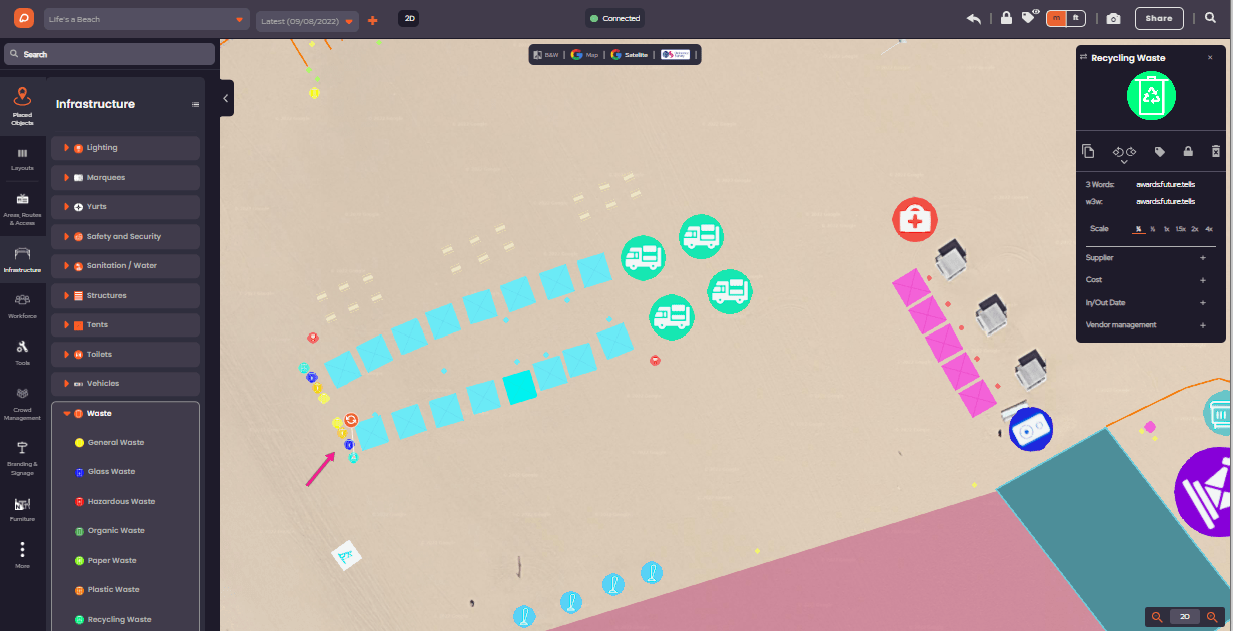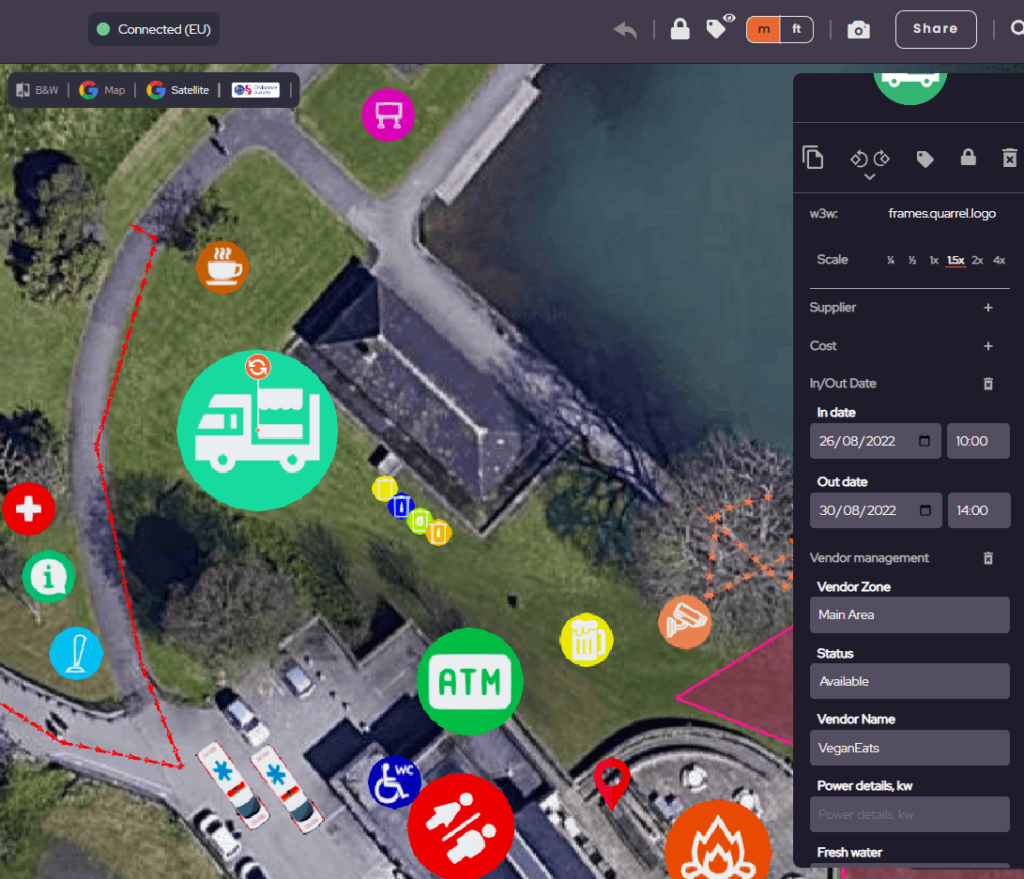Festivals need to be more sustainable
It is becoming an increasing reality that the effects of man-made global warming are affecting our everyday lives, and changes to how individuals and companies act are necessary. Research by the BBC estimated UK festival waste to be an average of 23,500 per year; an equivalent to 78 fully loaded Boeing 747 Jumbo Jets. In the US, it is estimated as major festival generates around 100 tonnes of solid waste per day!
For a festival planner, this need to be more sustainable can be intimidating. However, with tried and tested techniques from past festivals it is possible to deliver greener and more environmentally friendly festivals, without compromising attendee experience. So, you can decrease your carbon footprint and still put on a show.
According to Ecoexperts Glastonbury has managed to create a net positive impact on the climate; reducing CO2 emissions by planting trees, correctly managing waste and using solar power. Without effective waste management strategy, and huge efforts from festival staff and volunteers, their carbon emissions would likely be 174.5 tonnes higher! Whilst for smaller scale events, the impact may not be as severe as the footprint left by major music festivals, implementing small changes can make a HUGE difference.
So what can you do?
It is possible to make your festival more sustainable by tweaking your festival planning in a variety of ways. In this post, we will highlight six vital aspects of your festival and how past festivals have made them greener:
- Travel
- Energy
- Recycle
- Re-use
- Toilets
- Food and Drink
1. Travel
Whether your festival attracts 1,000 people or 200,000 attendees they will have to get there somehow!
Public transport is the perfect way to reduce your festival’s travel emissions. Whether you promote rail travel, coaches or cycling, just one attendee making the change from driving to public transport will help decrease your carbon emissions.
Glastonbury (UK) encourages its festival goers to arrive by bus or coach, combining coach travel into their ticket packages and partnering with Big Green Coach. 40% of Glastonbury’s festival goers arrive by coach, cutting out 20 cars worth of emissions in one coach journey!
Green Man Festival (UK) also promoted coach travel by subsidising national express tickets by 15%. They also idolise cycling as a mode of festival transport knocking off £10 per ticket if you agree to cycle with Red Fox Cycling.
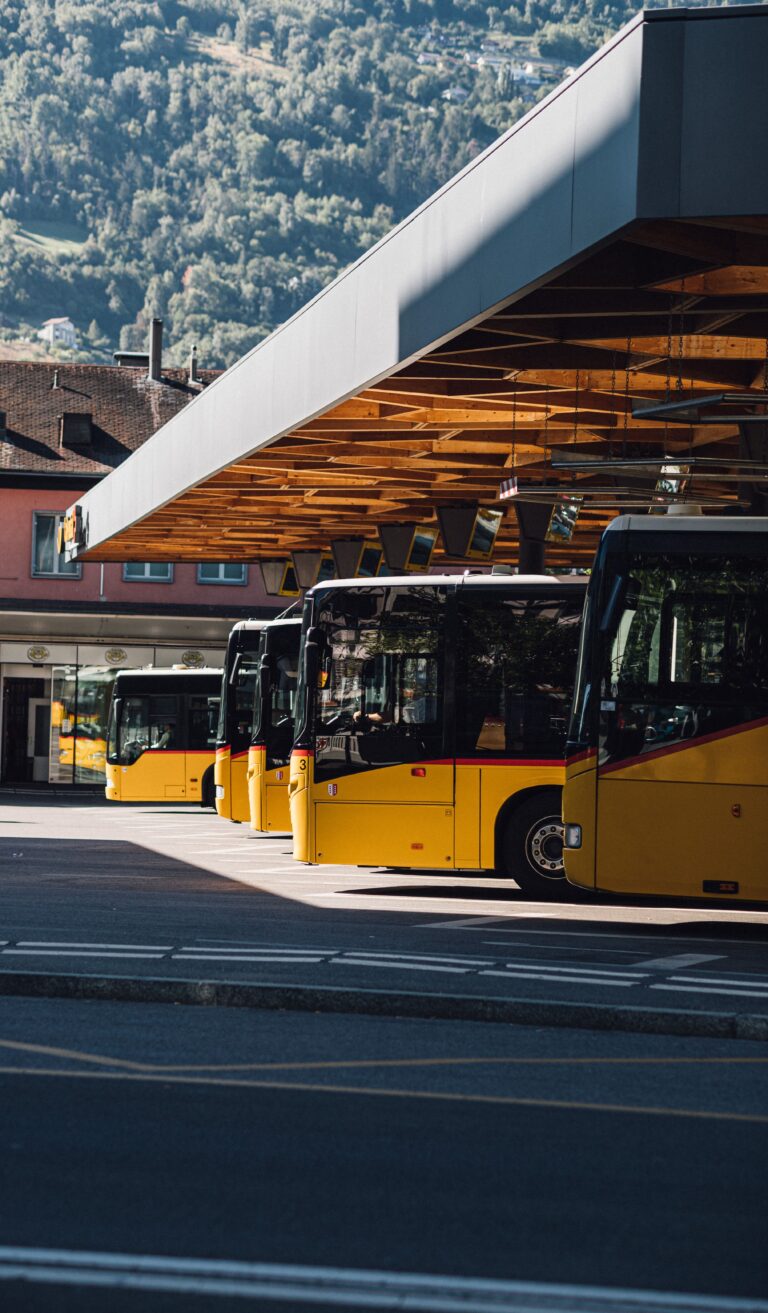
If your festival has a high global audience, you could take a leaf out of Hungary’s largest music festival’s book. Eighty per cent of Sziget’s carbon emissions come from aeroplane usage. To attempt to compensate for this, Sziget fans are encouraged to adopt a tree for 20 euros to compensate for their travel footprint, turning a formal agricultural field into an ecological paradise. Additionally, in 2022, Sziget provided all its attendees with free additional baggage for their tents, with Wizz Air. This helped decrease tent wastage and prevented attendees from buying new tents for one-time use. Implementing eco friendly festival ideas doesn’t limit the experience, it’s possible to design your festival’s sustainability initiatives to engage attendees and motivate them to participate.
2. Energy
It takes a lot of energy to power a festival but what can you do to minimise your emissions?
The world is shifting away from carbon emissions and more to renewable energy, and the event world is already getting involved! IEA predict that renewable energy use will increase by 60% by 2026 from the levels reached in 2020. Governments are becoming more supportive of renewable efforts following COP26 creating more scope for change.
Coachella (USA) gets its attendees involved with its ‘Energy Playground’, Powering their own energy sources, such as phone charging, by playing on the ‘Energy See-Saw’. The Movement of the see-saw generates kinetic energy which can then be used to charge the attendee’s electrical devices.
Terraforma (ITALY) contains a low-impact, solar-charged light system for their campsite and Secret Solstice (ICELAND) taps into Iceland’s national grid, allowing the festival to run on 100% geothermal energy.
Additionally, Secret Solstice takes place over the longest day of the year – With 24-hour daylight there’s no need for additional festival lighting. Taking advantage of natural phenomena could be a fun and effective way of making your event renewable.
Even countries with more unpredictable weather, like the UK can use solar energy! Glastonbury installed 1500m2 solar panels to cattle sheds, which have been generating energy for the last 30 years.
3. Recycle Recycle Recycle!
A report by Creative Carbon Scotland suggests UK festival goers create the equivalent of over 2.7kg of waste per person, per day. Festival organisers can implement sustainability initiatives to reduce waste.
Shambala (UK) enticed their attendees to recycle using a £10 recycling deposit, fully refundable if they bring their recycling to one of the festival’s recycling exchanges. In 2017 this led to 91% of their waste materials being recycled!
To tackle campsite waste, at Sziget you can even win a chance to be on the big screen with your favourite artists- if you vow to clear your camp correctly. Sziget 2022’s litter-picking volunteers got to work straight away after the final set on the main stage. Within an hour the main stage area was completely cleared with piles of rubbish sorted into recyclables and non-recyclables.
On the theme of pledges for every person who attended We Love Green (FRANCE) Ecosia pledged to plant an extra 80,000 trees in Uganda and Indonesia.
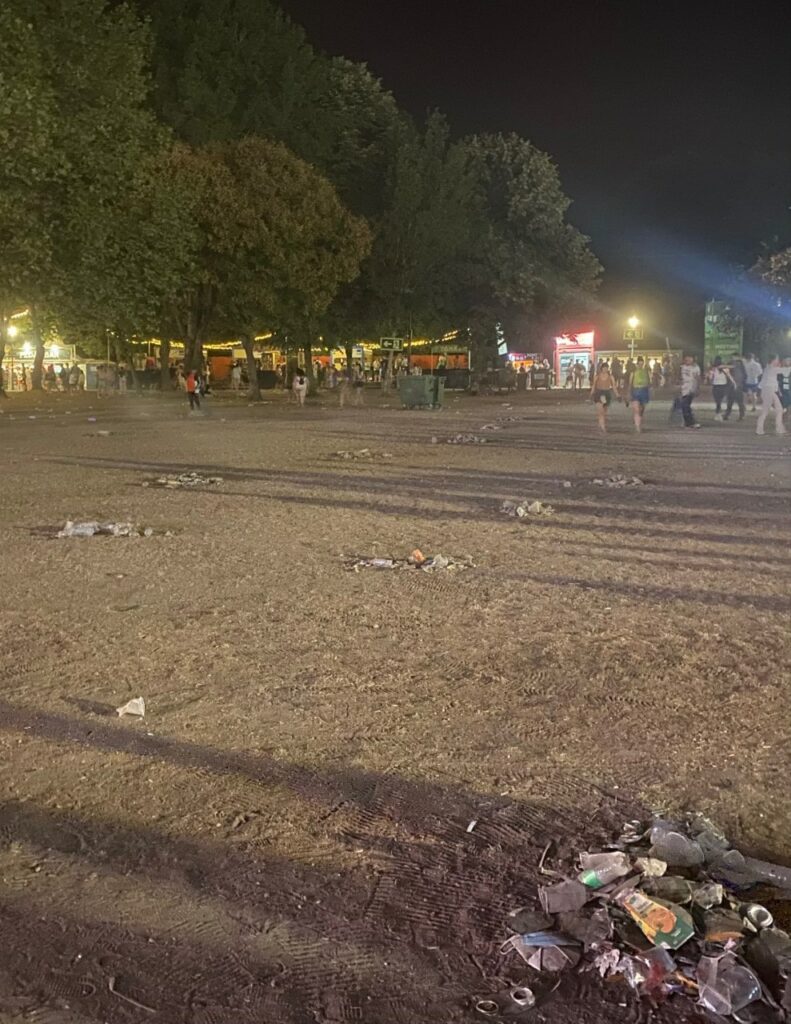
Image from Sziget 2022 of clean-up efforts from the Sziget team on the final day of the festival.
In OnePlan we have your bins covered with multiple options and clear differentiation between recycling types! This makes it easy for both you as the planner and your attendees to do your bit for the environment! Access these through the “Waste” section on the left-hand panel. So far this year, waste and recycling items have been placed in over 140 events in 17 different countries.
4. Re-use to be more sustainable
Sziget, introduced a reusable cup system, where event attendees can buy their first cup and take the used one back to receive a new one! A token system is also available, so the attendees don’t have to lug the cups around all night! The Re-usable cups also make the perfect souvenir, carrying on their eco-friendly actions outside of your festival! There are multiple companies selling branded reusable festival cups including: Happy Cups, Festival Cups and EventCupSoloution.
Manchester International Festival (UK) creates monumental artwork made out of previous years’ recycled items or items to reuse yourself! Marta Minujín’s sculpture of ‘Big Ben Lying Down with Political Books’ is designed to be covered in 20,000 real books, which at the end of the festival attendees will be invited to take home.
Splendour in the Grass (AUSTRALIA) is partnering with charities Social Futures and Momentum Collective, who will be collecting all non-damaged camping goods to pass them on to people in more disadvantaged areas of Byron Bay. Helping both the environment and the local community.
5. Toilets
There’s nothing glamorous about festival toilets but it is possible to make them sustainable!
The answer is compost toilets!
Glastonbury have 1,200 compost toilets sitewide, yielding 500+ tonnes of horticultural compost each year!
One of the pioneering companies from compost toilets is Natural Event. In the last 15 years, Natural Event has operated at over 350 events across 9 different countries. Natural Event offers complete hire of cubicles and urinals to festivals and can also tailor design a system to suit specific conditions and site requirements. They use no energy, release no chemicals and save 100% of water use.
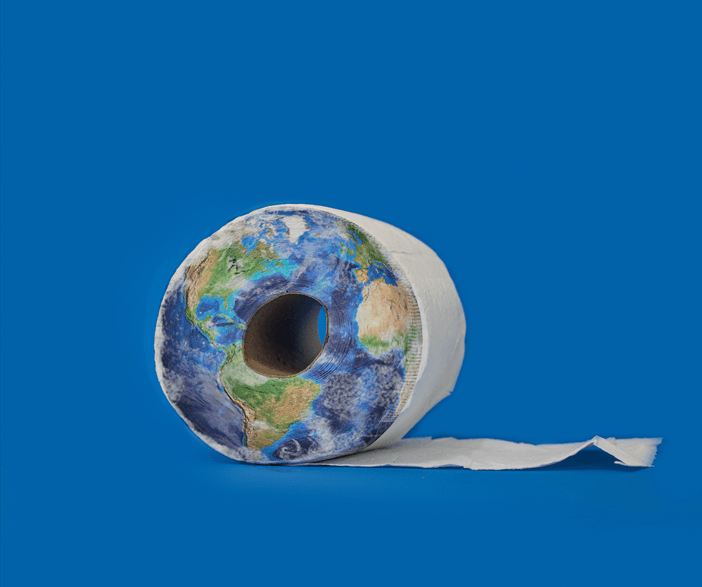
To prevent soil pollution, Czeremcha (POLAND) worked with Greenland Technologica EM to introduce EM microbial toilets as a part of the “Earth Toilet Project”; launched by EM Seikatsu in Japan. After use of the toilets, the customers sprayed EM, with the staff cleaning toilets with EM 3 times a day. EM was highly successful with little chemical change in the soils and an effective reduction in smell. A post-event survey found that customers were happy with both the odour and the hygiene.
6. Food and Drink
Finally, you need to provide food and hydration for your customers!
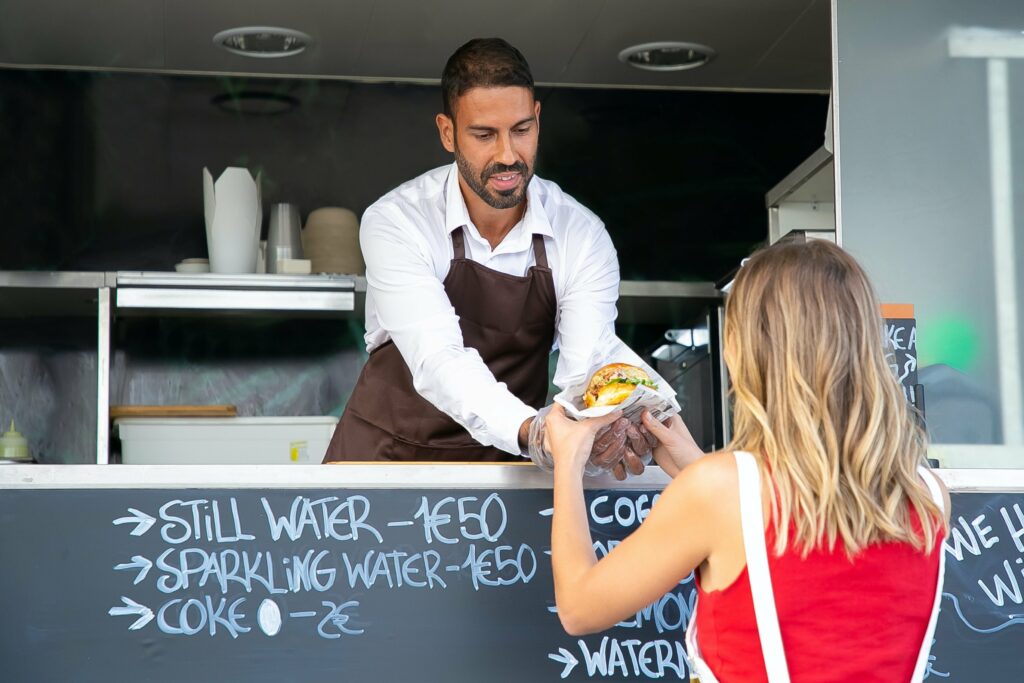
Lollapalooza (USA) has hundreds of hydration stations and partners with Path Water creating the campaign #RefillIt, selling aluminium bottles to refill sitewide. In 2019, over 800,000 bottles of water were refilled.
Shambala is now 100% veggie and 33% vegan! On top of this festivals worldwide have come forward to say they are cutting down on meat options at their events and promoting plant-based alternatives with a significantly lower carbon footprint. Vegan Food and Living provide a list of popular vegan food vendors across the UK, ranging from sushi to doughnuts. Feast it have a database of 1500+ vegan vendors, providing a platform for contacting and booking your caterers.
Bringing in food can also release an extortionate amount of greenhouse gases. NorthSide (DENMARK) demand their suppliers provide organic products and local produce rather than travelling a long distance. In 2017 NorthSide achieved 100% organic food and wine.
Bringing in local vendors is good for both your community as well as the environment! Have a look at food companies near you!
With OnePlan you can add vendor information to your plan. On the right-hand panel you can add vendor names, in and out dates and all the vendor’s needs. Try it out now with our freemium package at: https://www.oneplanevents.com/
There’s so much you can do to make your festival sustainable. Hopefully you have been inspired by this blog and have some sustainable festival ideas of your own! OnePlan has multiple eco-friendly items you can place in your event plans. Feel free to book a demo with our experts to start planning better with OnePlan. Happy planning!


